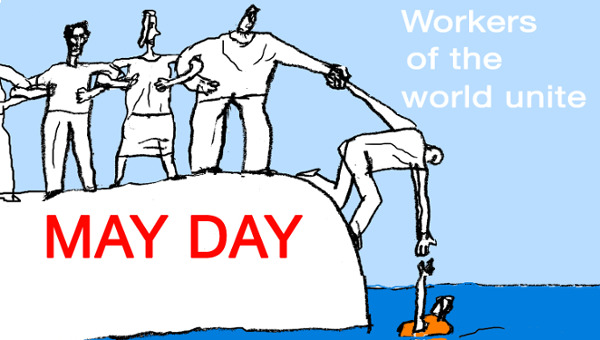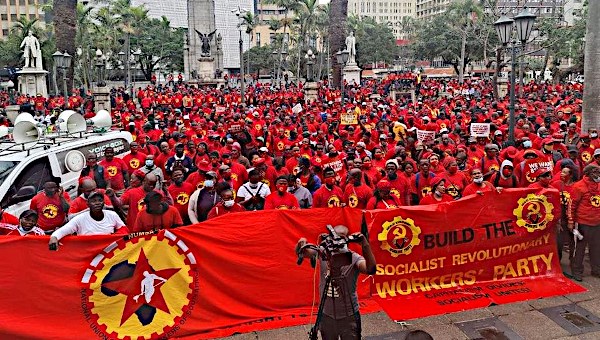Celebrating and Struggling This May Day
The Long, Hard Haul at the Vale Inco Strike
The fight of popular and workers’ movements across the world against neoliberal capitalism in the current period is not an easy one. The increasing reliance on global markets and corporate power as the vehicles for organizing economic, social and political life over the last two decades has yielded increasing inequalities between and within countries, and a long-term decline in workers’ relative living standards. Conditions in workplaces have deteriorated and intensified; work has become more precarious; and unions have been struggling to organize and re-make themselves.

Exit Strategies and Political Struggle
Governments are now struggling to find ‘exit strategies’ from the emergency measures, and particularly fiscal deficits and debt loads to return to neoliberal norms on the balances between the state and the private sector. But the banks and the speculators in global financial markets are coming back ferociously to bite the government hand that just bailed them out! Nothing could be more grotesque and revealing of the irrationality of capitalist social relations: after being bailed out by governments, financial capital is now demanding that workers and the popular sector pay for the privilege of having rescued them in reduced wages, higher taxes and less public services.
Who will pay for the crisis? The financial sector, the wider capitalist class and the conservative and social democratic parties are all arguing that workers, the poor and the public sector must pay. In rejecting the gross unfairness and the moral obscenity to preserve bankers’ bonuses while cutting the incomes of everyone else, a wave of public sector strikes has been sweeping across Greece, Portugal, Spain, Ireland and other countries of Europe. In North America, the fight against public sector austerity has set up an unprecedented set of public struggles in California over the university system, wage cuts and almost everything that public finances touch upon.
These same struggles are now beginning to emerge in Canada as governments move into restraint, and attempt to reconstruct neoliberal budgetary and tax policies, while insulating the financial sector from any measure of reform. Indeed, the major banks in Canada, conservative think-tanks and all the major political parties – from the Conservatives to the NDP – are supporting the policy shift. A decade of austerity is being mooted, with the recent budgets of the Federal, Quebec and Ontario governments leading the way.
Public sector confrontations will inevitably be coming to Canada as well. But here the key battles still reside in the private sector as concession demands from employers – following on the heels of concessionary setbacks in the auto sector in the midst of the crisis – have driven a series of lockouts and strikes at U.S. Steel against USW in Hamilton, at Sears Canada against USW at Vaughan, Ontario, at the Massey Centre for Women against SEIU, amongst many across Canada. The longest and most important of these disputes being that of the United Steelworkers at Vale Inco in Sudbury.
The Long Hard Haul at Vale Inco
Nine and one-half months ago, on July 13, 2009 to be precise, 3,100 members of USW Local 6500 in Sudbury together with 200 members of Local 9508 in Goose Bay and Voisey Bay, Labrador, and 120 members of Local 6200 in Port Colborne, Ontario, began walking the picket against Vale Inco. This is now the longest strike in the history of mining in the Sudbury Basin surpassing the 8 month, 23 day strike fought by Local 6500 in 1978-79.
If anyone needed a precise example of what capitalist globalization means, this is it. In 2006, the assets of Inco were purchased by CVRD (now Vale Inco), a Brazilian-based mining conglomerate. And very early on, the company signalled that its operations had to be “sustainable in all pricing cycles” and to ensure this a “unified approach to compensation” was necessary throughout all of its global operations – from Brazil, to New Caledonia, and to Sudbury.
The strike was prompted by Vale Inco’s demands that the long-existing, and hard fought, defined benefit pension plan be replaced by one based on defined contributions would apply to all new hires. Second, the ‘nickel bonus,’ effectively a form of profit sharing when nickel prices are high, that could add up to 25 percent of a production worker’s annual base income, was to be eliminated. And third, a three year wage freeze was tabled.
USW members said ‘no’ to selling out a younger generation of workers and to accepting a declining standard of living.
In response, Vale Inco has been ratcheting up the conflict and potential for much more by employing contractors and replacement workers to continue some production and is now threatening to bring in several hundred scabs to re-start full production. There is little reason to doubt Vale’s sincerity given that throughout this strike they have employed tactics not seen in Sudbury since the 1930s and 1940s. This includes hiring a Toronto-based security firm that has deployed security guards who actively intimidate strikers with video and audio surveillance. Vale has also gone so far as to accuse the union of racism. Unionists from Brazil to New Caledonia were quick to address this charge against their Canadian comrades.
The Steelworkers have engaged in one of the most creative struggles seen in Canada for a very long time. They have sent their own members across the globe to meet with other workers and build international links of solidarity. Sudbury even played host to an international conference on globalization and work that brought hundreds of worker activists from the Global North and South together to identify common struggles and develop strategies. However, Vale Inco appears intent not on arriving at a settlement but rather on destroying the miners’ union. And there will be an extremely high, and unnecessary, price for that.
May Day 2010
This year’s May Day, the International Workers’ Day celebrated around the world, has as its backdrop these public sector struggles spreading across the world, and bitter disputes against concessions-demanding private sector employers across Canada
. The financial crisis revealed the greed, speculation and exploitation that lies at the heart of capitalism. The conflicts over exit strategies with their demands for concessions from workers and cuts in public services to preserve the financial system the class power that animates politics and shows how slight is the real world of liberal democracy. The rebuilding of a socialist movement in Canada has never been more crucial. May Day always provides occasion for reflection on the state of the labour and socialist movements in Canada and around the world. This year’s May Day also carries the insistence that we turn our collective attention to the future of building the anti-capitalist movement. •
What You Need to Know About May Day
Leo Panitch
For more than 100 years, May Day has symbolized the common struggles of workers around the globe. Why is it largely ignored in North America? The answer lies in part in American labour’s long repression of its own radical past, out of which international May Day was actually born a century ago.
The seeds were sown in the campaign for the eight-hour work day. On May 1, 1886, hundreds of thousands of North American workers mobilized to strike. In Chicago, the demonstration spilled over into support for workers at a major farm-implements factory who’d been locked out for union activities. On May 3, during a pitched battle between picketers and scabs, police shot two workers. At a protest rally in Haymarket Square the next day, a bomb was tossed into the police ranks and police directed their fire indiscriminately at the crowd. Eight anarchist leaders were arrested, tried and sentenced to death (three were later pardoned).
These events triggered international protests, and in 1889, the first
congress of the new socialist parties associated with the Second International (the successor to the First International organized by Karl Marx in the 1860s) called on workers everywhere to join in an annual one-day strike on May 1 – not so much to demand specific reforms as an annual demonstration of labour solidarity and working-class power. May Day was both a product of, and an element in, the rapid growth of new mass working-class parties of Europe – which soon forced official recognition by employers and governments of this “workers’ holiday.”
But the American Federation of Labor (AFL), chastened by the “red scare” that followed the Haymarket events, went along with those who opposed May Day observances. Instead, in 1894, the AFL embraced president Grover Cleveland’s decree that the first Monday of September would be the annual Labor Day. The Canadian government of Sir Robert Thompson enacted identical Labour Day legislation a month later.
Ever since, May Day and Labour Day have represented in North America the two faces of working-class political tradition, one symbolizing its revolutionary potential, the other its long search for reform and respectability. With the support of the state and business, the latter has predominated – but the more radical tradition has never been entirely suppressed.
This radical May Day tradition is nowhere better captured than in Bryan Palmer’s monumental book, Cultures of Darkness: Night Travels in the Histories of Transgression [From Medieval to Modern] (Monthly Review Press, 2000). Palmer, one of Canada’s foremost Marxist labour historians, has done more than anyone to recover and analyze the cultures of resistance that working people developed in practising class struggle from below. He’s strongly critical of labour-movement leaders who’ve appealed to those elements of working-class culture that crave ersatz bourgeois respectability.
Set amid chapters on peasants and witches in late feudalism, on pirates and slaves during the rise of mercantile imperialism, on fraternal lodge members and anarchists in the new cities of industrial capitalism, on lesbians, homosexuals and communists under fascism, and on the mafia, youth gangs and race riots, jazz, beats and bohemians in modern U.S. capitalism, are two chapters that brilliantly tell the story of May Day. One locates Haymarket in the context of the Victorian bourgeoisie’s fears of what they called the “dangerous classes.” This account confirms the central role of the “anarcho-communist movement in Chicago [which] was blessed with talented leaders, dedicated ranks and the most active left-wing press in the country. The dangerous classes were becoming truly dangerous.”
The other chapter, a survey of “Festivals of Revolution,” locates “the celebratory May Day, a festive seizure of working-class initiative that encompassed demands for shorter hours, improvement in conditions, and socialist agitation and organization” against the backdrop of the traditional spring calendar of class confrontation.
Over the past century communist revolutions were made in the name of the working-class, and social democratic parties were often elected into government. In their different ways, both turned May Day to the purposes of the state. Before the 20th century was out the communist regimes imploded in internal contradictions between authoritarianism and the democratic purpose of socialism, while most social democratic ones, trapped in the internal contradictions between the welfare state and increasingly powerful capital markets, accommodated to neoliberalism and become openly disdainful of “old labour.”
As for the United States, the tragic legacy of the repression of its radical labour past is an increasingly de-unionized working-class mobilized by fundamentalist Christian churches. Canada, with its NDP and 30-per-cent unionized labour force, looks good by comparison.
Working classes have suffered defeat after defeat in this era of capitalist globalization. But they’re also in the process of being transformed: The decimated industrial proletariat of the global North is being replaced by a bigger industrial proletariat in the global South. In both regions, a new working-class is still being formed in the new service and communication sectors spawned by global capitalism (where the eight-hour day is often unknown). Union movements and workers’ parties from Poland to Korea to South Africa to Brazil have been spawned in the past 20 years. Two more books out of Monthly Review Press – Ursula Huws’ The Making of a Cybertariat (2003) and the late Daniel Singer’s Whose Millennium? Theirs or Ours? (1999) – don’t deal with May Day per se, but capture particularly well this global economic and political transformation. They tell much that is sober yet inspiring about why May Day still symbolizes the struggle for a future beyond capitalism rather than just a homage to the struggles of the past. •
Leo Panitch teaches political economy at York University, is co-editor of The Socialist Register and author of Renewing Socialist Democracy, Strategy and Imagination.





